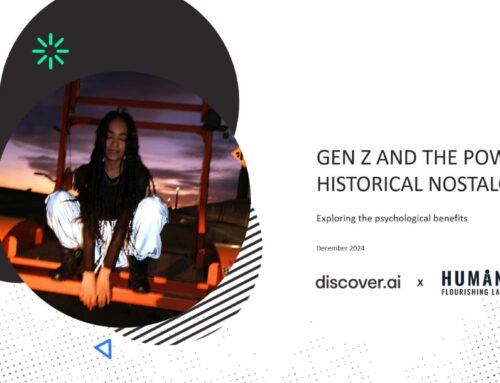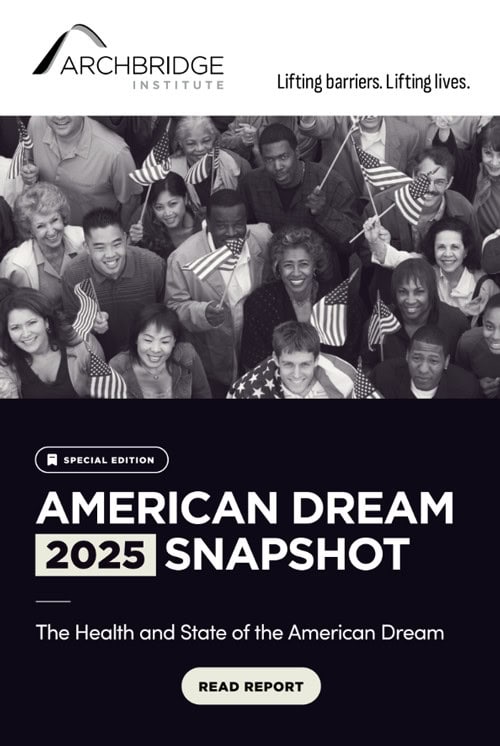
Introduction
After the 2024 election, there was speculation that the vibes around the American Dream and American patriotism were improving, that more people were betting on America to succeed—at least on paper. Six months later, uncertainty clouds the prospects of a prospering America. Whether it be the confusion surrounding “Liberation Day” tariffs and trade negotiations, ballooning fiscal issues (which led to the downgrade of U.S. debt), or heightened political tensions and polarization, the country continues to face challenges in policy and culture.
However, one area of American life remains resilient: the American Dream. For the sixth year in a row, we surveyed Americans about the American Dream and discovered that in the eyes of its citizens, the American Dream continues to be alive and well. Despite the aforementioned challenges, 7 in 10 Americans are optimistic about the American Dream. Fewer people believe the American Dream is out of reach, as compared to last year’s results, and the American Dream continues to stand as a holistic, unifying narrative for people across race, income, education, and political groups. This year’s report highlights many reasons to be hopeful and some important trends to watch for anyone interested in the health and state of the American Dream.
Today’s younger generations are the most negative about the opportunity to pursue better, richer, and fuller lives. To paraphrase President Ronald Reagan: The American Dream is never more than one generation away from extinction. We must continue to foster support—economic, psychological, and cultural—for the American Dream to flourish. In a follow-up question, most Americans identified economic conditions as the biggest barrier to their American Dream. This suggests the need for policy reforms, outreach, and education to remove economic barriers at the state and federal levels. We can also embrace the unifying nature of the American Dream to reinvigorate our shared national identity and pursue positive-sum solutions. Finally, each of us can continue to propel the American Dream by taking actionable steps in our own lives to overcome obstacles and reach our fullest potential.
For this survey, we partnered with NORC at the University of Chicago and its AmeriSpeak® panel. AmeriSpeak® is a probability-based panel designed to be representative of the U.S. household population. Randomly selected U.S. households are sampled using area probability and address-based sampling, with a known, nonzero probability of selection from the NORC National Sample Frame. The nationally representative sample consisted of 2,131 respondents. The survey was conducted May 1-5, 2025.
Key Findings
- Most Americans (69%) believe they have achieved the American Dream or are on their way to achieving it, regardless of race, income, or education. This positive attitude is consistent with past surveys and represents a small increase from last year. Only 30% of people said the American Dream is out of reach.
- Americans are less optimistic about their fellow citizens, with only 51% believing that most Americans can achieve their American Dream. This is consistent with last year’s finding and continues to show a gap between people’s perceptions of their own situation and others.
- Across all demographics, a majority of Americans agree that most people believe in the American Dream and that Americans can be united around a shared belief in the American Dream (66% and 65%, respectively). These beliefs are slightly more popular than a year ago.
- Most Americans regard living better and fuller lives—rather than simply becoming wealthy—as essential to the American Dream. “Freedom of choice in how to live” (83%) and “having a good family life” (80%) continue to be the most important achievements associated with the American Dream. In comparison, only 15% of people say becoming wealthy is essential, down from 19% last year. Other factors include retiring comfortably (72%), owning a home (52%), having a successful career (45%), and making valuable contributions to the community (34%).
- Intergenerational mobility is an important tenet of the American Dream. Most of today’s U.S. adults believe they have more or about the same opportunities as their parents, with just 23% saying they have fewer opportunities than their parents.
- A majority of American parents are similarly optimistic about their children’s opportunities. However, nearly a quarter of parents worry that their children will have fewer opportunities than they did, a trend that has increased over the past three years.
- Federal tariff policies are hurting most Americans’ prospects of achieving the American Dream. More than half (58%) of Americans believe recent tariff increases will make it more difficult for them to achieve the American Dream; only 12% say higher tariffs will help them. Among Republicans, 24% think the administration’s new trade policies will help them, while 31% see them as a barrier, and 43% say they will have no effect.
- When asked about advancements in artificial intelligence (AI), most Americans are ambivalent about the effects of technology on the American Dream. About half (51%) of U.S. adults think AI will not affect their pursuit of the American Dream; 31% of people think it will have a negative effect, and 16% think it will have a positive effect.
The American Dream Continues to Be Alive and Well
For the sixth year in a row, we conducted a survey to explore how American citizens think and feel about the American Dream, and for the sixth year in a row, we discovered good news. When asked directly about their family’s pursuit of the American Dream, Americans paint a picture that is overwhelmingly positive. People today continue to embrace the American Dream, even showing a slight uptick in optimism from last year. Despite national headlines and negative political discourse, in the eyes of the American people, the American Dream is alive and well.

As Table 1 shows, 69% of Americans say they have either achieved the American Dream or are on their way to achieving it. Only 30% of people think the American Dream is out of reach. This represents a slight improvement from last year, when 32% of Americans were pessimistic about their chances of achieving the American Dream. You can compare these results in Table 2.
Over the past six years, the percentage of Americans who believe they have achieved the American Dream has remained relatively stable. However, fewer Americans believe they are on their way to achieving the American Dream—and more say it is “out of reach”—than in 2020-2023. We hope to see the improvements in this year’s results continue next year.
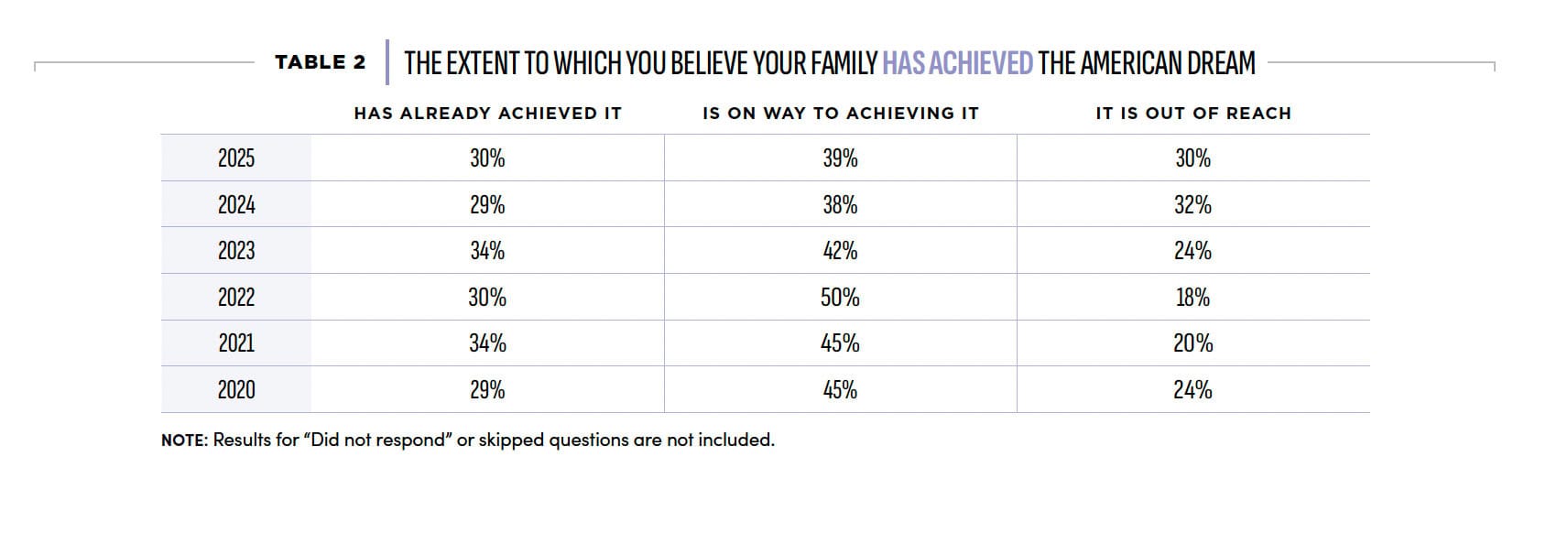
When we break down the results by demographic groups, a few trends stand out. Younger Americans are the most pessimistic age group when it comes to the American Dream. Nearly twice as many adults ages 18-29 believe it is out of reach (39%) compared to adults ages 60+ (20%). This generational gap has been a consistent finding of the American Dream Snapshot. It could be the case that younger Americans simply haven’t had enough time to pursue or achieve their dreams.
Another consistent trend, shown in Table 3, is the gap between people with and without a college degree. Of those with at least a bachelor’s degree, only 16% believe the American Dream is out of reach. For all other Americans, it is more than one-third, and more than one-half of Americans without a high school diploma. A similar gap exists between high- and low-income earners.
Across ethnicities, a majority of all groups are optimistic about the American Dream for their family. Finally, when it comes to political affiliation, Republicans and Democrats are more optimistic than Independents. Republicans saw the largest increase from last year; 78% believe they have achieved or are on their way to achieving the American Dream, compared to 72% last year.
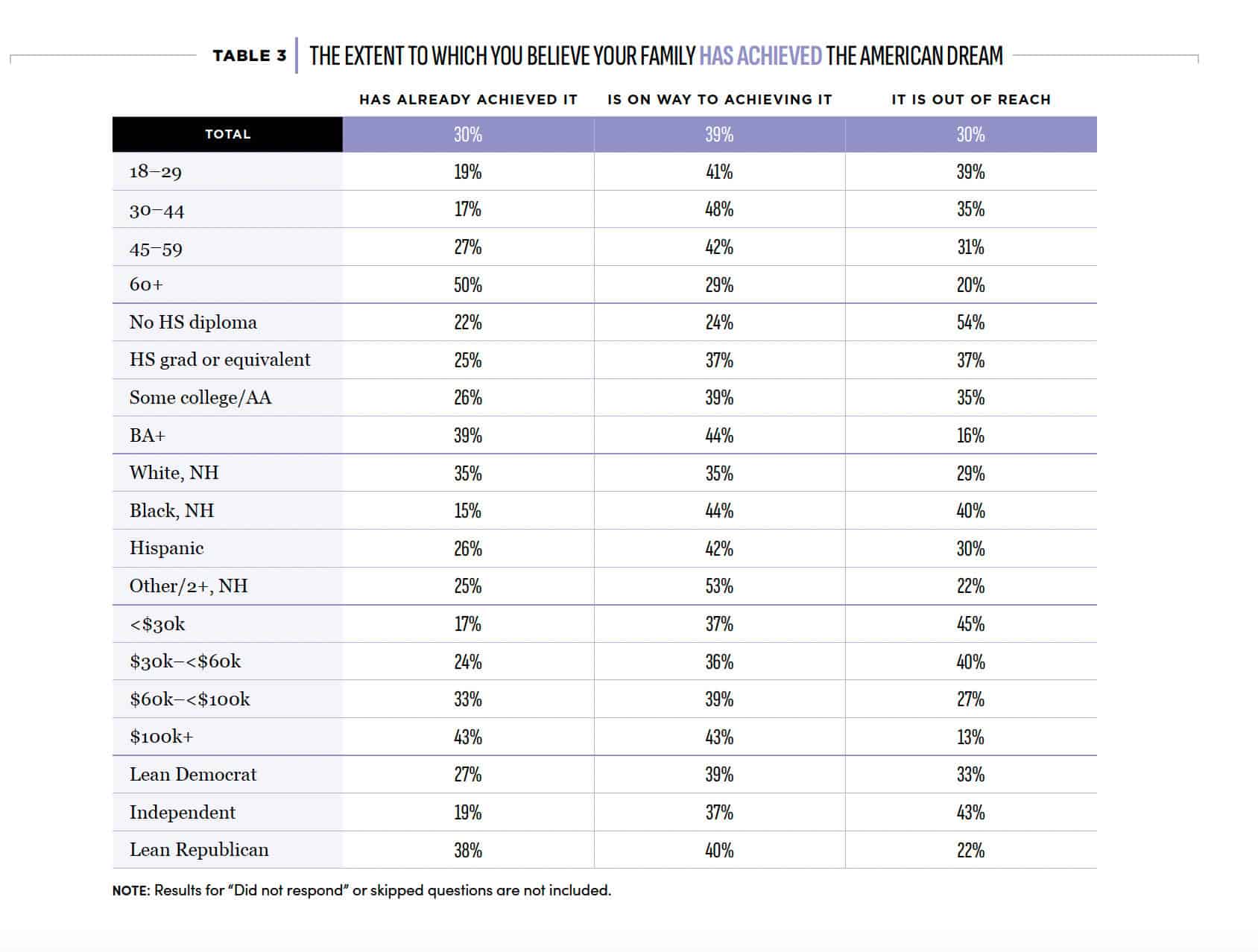
To further understand the forces shaping these beliefs, we added two follow-up questions to this year’s survey. For people who said the American Dream is out of reach, we asked them to identify the most important barrier facing their family. As Table 4 shows, nearly 6 in 10 respondents cited poor economic conditions as their biggest obstacle. This response included things like rising housing prices, high cost of living, low wages, and other financial factors.
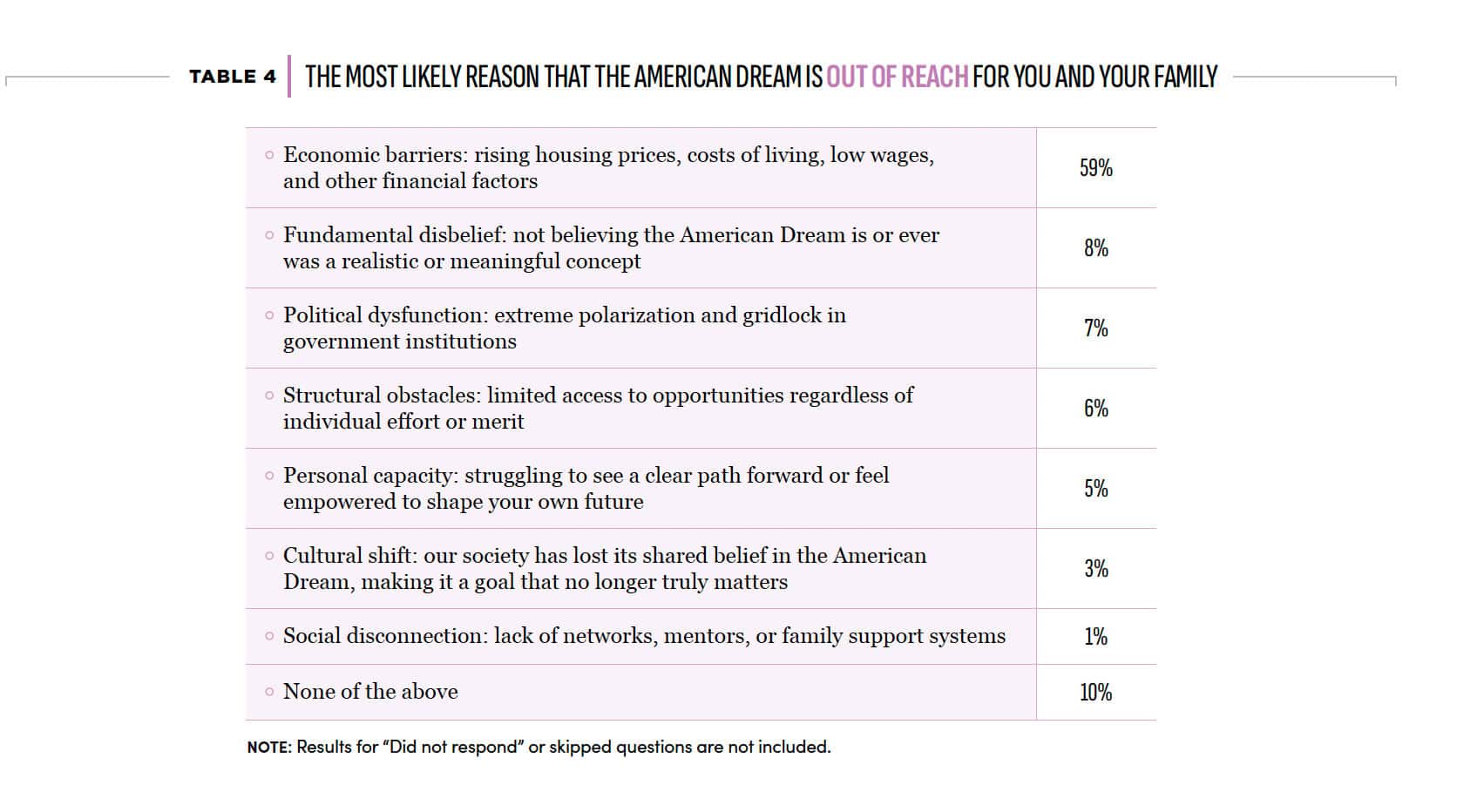
The overwhelming agreement on this issue reveals good news and bad news for the state of the American Dream. The bad news is that current economic conditions are not helping people think positively about the American Dream. This is a big concern, and policymakers should look for solutions to remove economic barriers to social mobility. Some potential reforms include removing tariffs and reducing economic uncertainty, addressing man-made causes of inflation, improving zoning regulations to make housing more affordable, and removing barriers to entrepreneurship so people have access to more opportunities and higher wages.
On the other hand, there is good news. Poor economic conditions are often the result of man-made policies, which means they can be addressed with man-led solutions. Cultural pessimism and lack of motivation would be much more difficult to correct. Fortunately, only 8% of people surveyed have lost belief in the American Dream as a realistic or meaningful concept. That represents just 2.4% of total respondents (8% of the 30% who said the American Dream is out of reach). Similarly, very few people cited political dysfunction, structural obstacles, or a lack of personal capacity to shape their future. This demonstrates that Americans continue to believe in the fundamental promise of the American Dream: that people have the agency and capability to pursue opportunities for a better life. While we must strive to improve the economic environment, cultural belief in the American Dream remains healthy. Moreover, these findings are consistent across all of the demographic categories reported in Table 5.
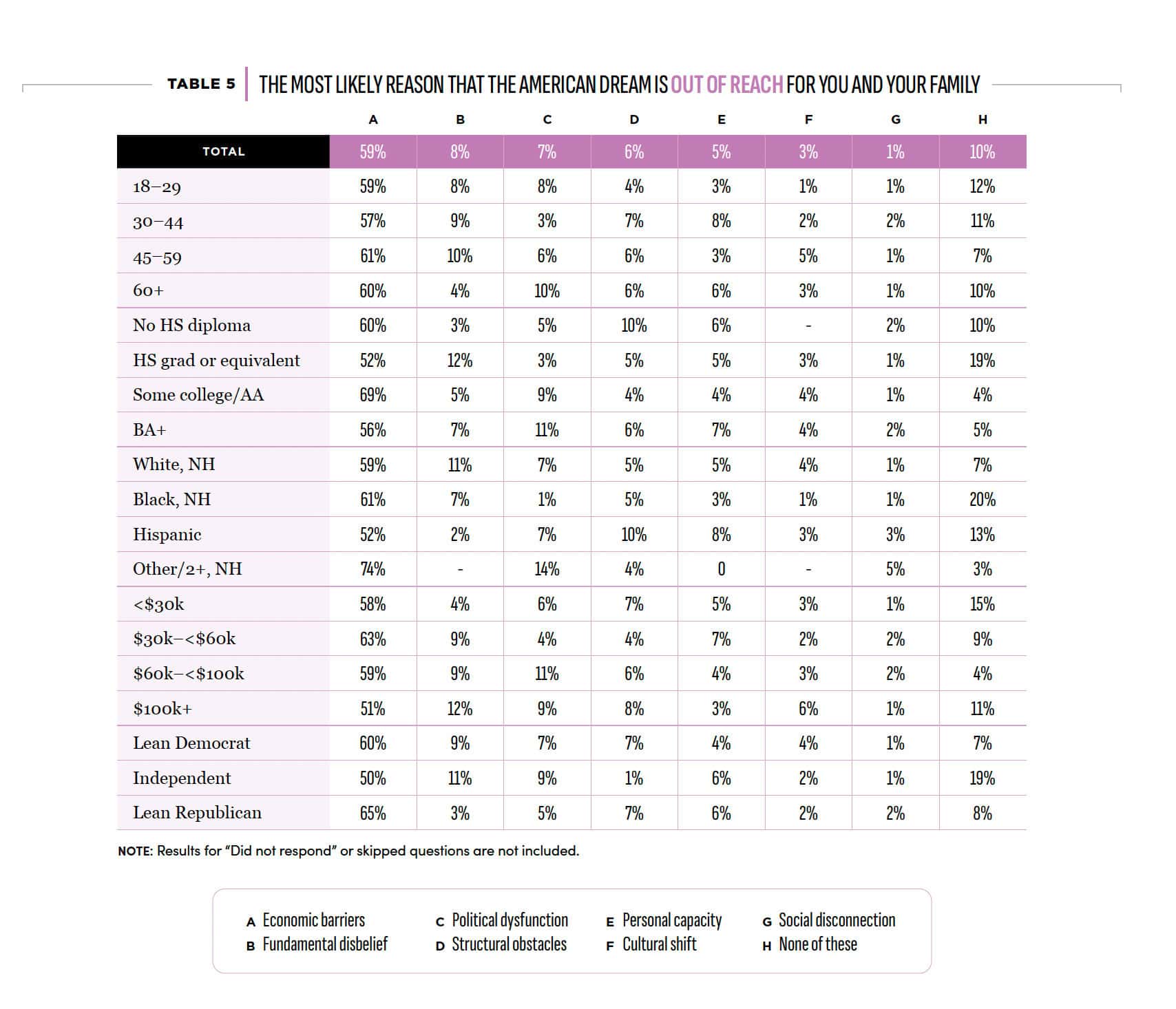
Our second follow-up question focused on those who said they are on their way to achieving the American Dream. We sought to better understand how Americans in this transitional category viewed their situation. The results can be found in Table 6.
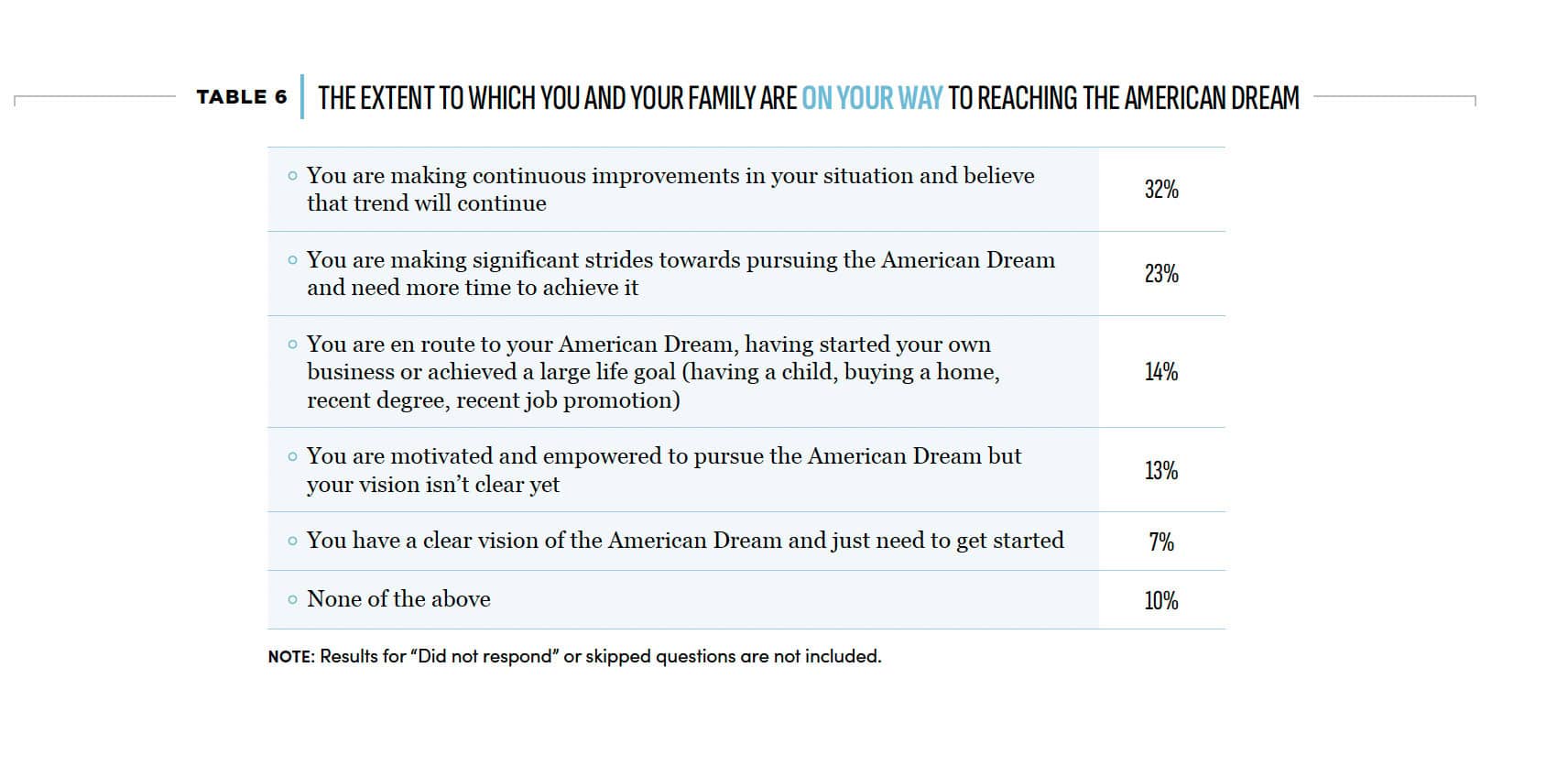
The most popular response overall was “I have made continuous improvements in my situation and believe that trend will continue.” However, Table 7 reveals some generational differences. Not surprisingly, younger Americans are more likely to say they need “more time” to achieve their American Dream. Similarly, respondents ages 18-29 are more likely to say they do not yet have a clear vision of their American Dream. This suggests a possible explanation for why younger cohorts are less likely to report achieving the American Dream.
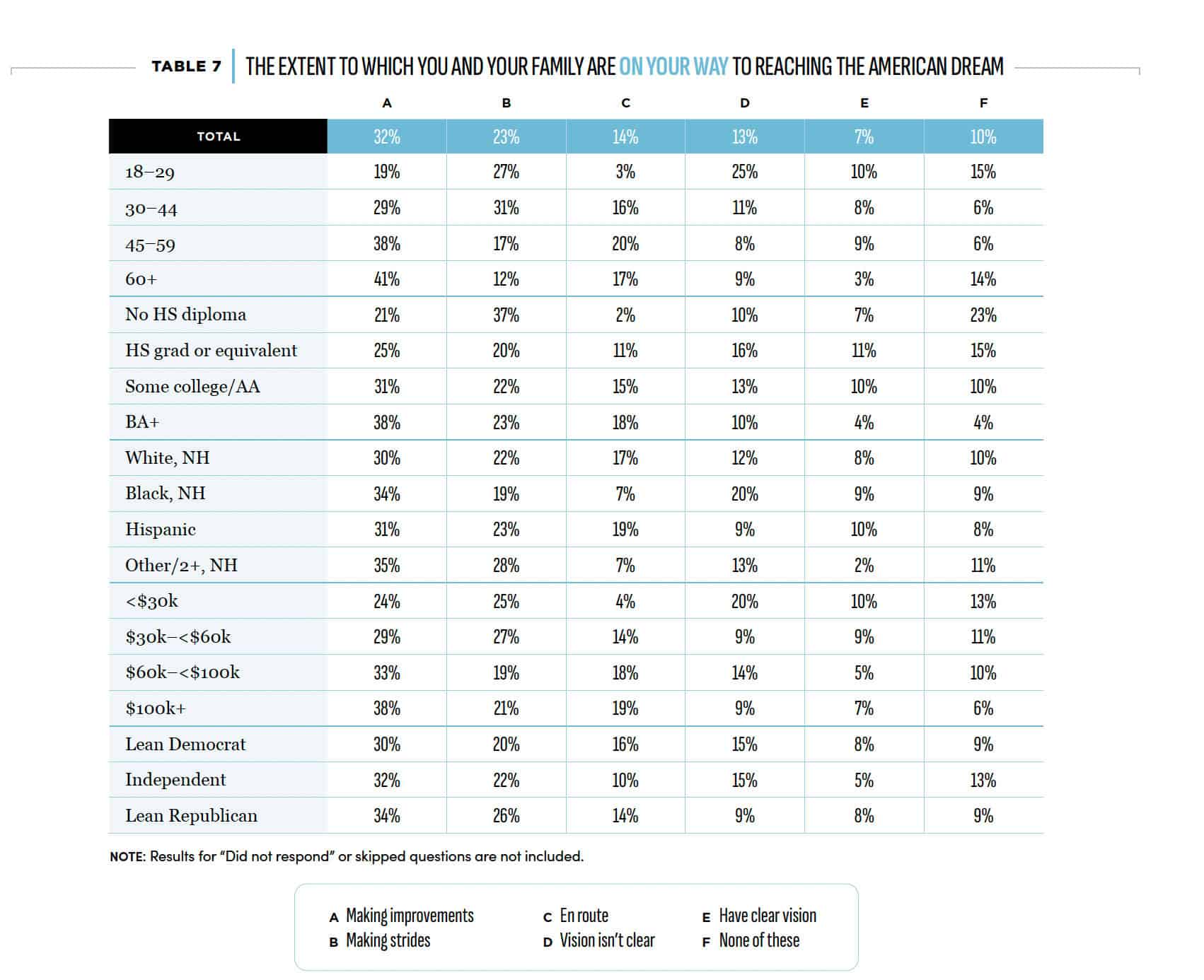
The American Dream and Society
For the second year in a row, we expanded the survey to ask people about their external views of the American Dream. These results can be found in Table 8.
Compared to the above results, which focused on people’s personal circumstances, these questions asked people to zoom out and think about the country as a whole. Similar to last year, we found that people are more pessimistic when it comes to others. Whereas 69% believe they have either achieved or are on their way to achieving the American Dream, only 51% of people agree that most Americans can achieve the American Dream. Nearly half of Americans don’t believe their fellow citizens can achieve the American Dream, despite only 30% of people holding this view for themselves.
Fortunately, a majority of people say most Americans believe in the American Dream, and they still see the American Dream as a unifying narrative. In fact, only 6% and 8% of Americans strongly disagree with those statements, respectively. Compared to 2024, Americans are slightly more positive about the American Dream as a national theme.
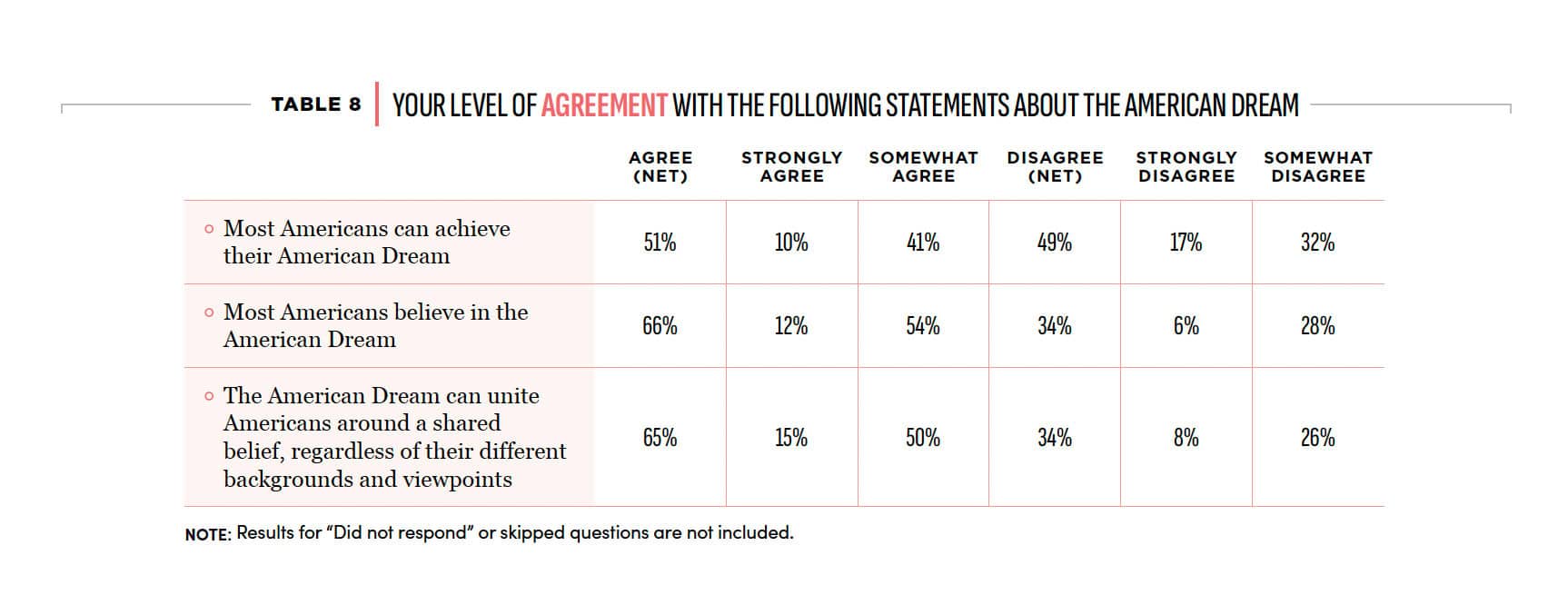
Looking into the demographics of each of these questions reveals some useful themes. Again, younger people are less likely to believe Americans can achieve the American Dream and that it can serve as a unifying narrative. In addition, Table 9 shows that Republicans have a more positive, outward-directed view of the American Dream than Democrats and Independents.
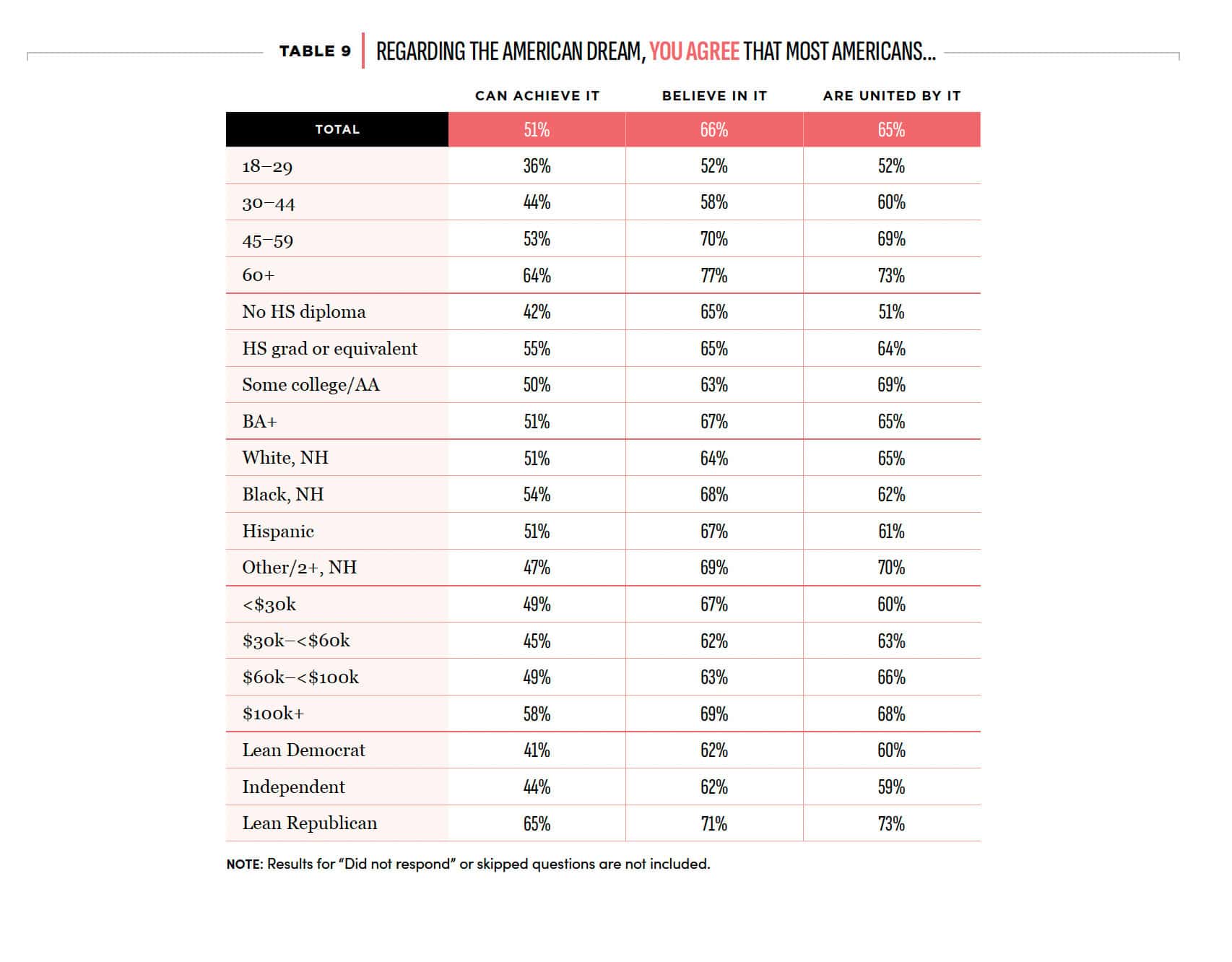
The American Dream Is About Freedom and Family
Many caricatures of the American Dream focus on wealth, fame, and material things. To some extent, this is understandable. As previously discussed, good economic conditions are an important factor for achieving success. However, when asked about the most important ingredients for the American Dream, most people focus on holistic measures of flourishing. For the sixth year in a row, Americans report that “freedom of choice in how to live” and “having a good family life” are essential to their view of the American Dream (83% and 80%, respectively).
Although many people say owning a home, having a successful career, and becoming wealthy are important to them, they do not place the same value on these achievements as freedom, meaning, and family. These results are highlighted in Table 10.
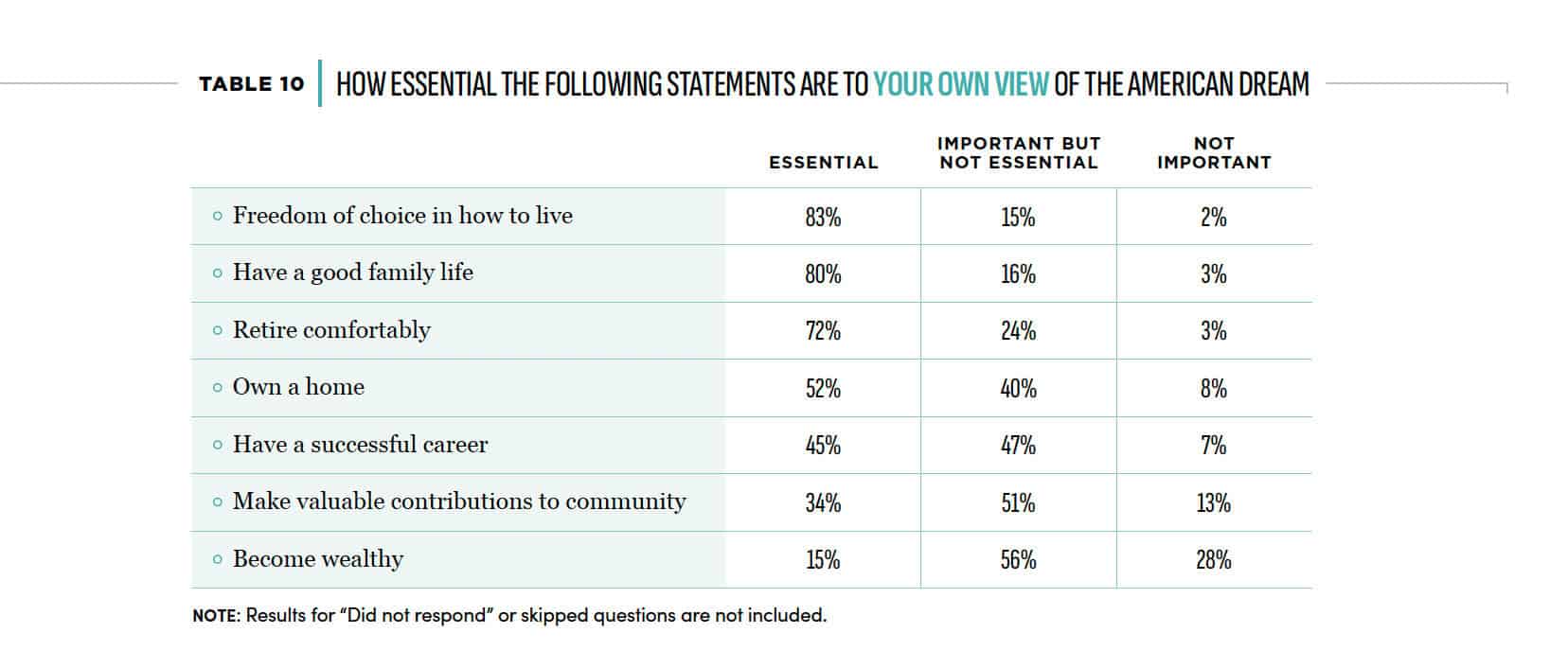
Table 11 shows annual comparisons revealing the robustness of the results over the past six editions. Each of these achievements can be mutually reinforcing when it comes to living “the good life.” However, it’s important to recognize people have varied definitions and goals that translate to 340 million unique American Dreams, one for each American. That is the beauty of our nation’s diversity: we can each hold a unique view of what constitutes a better, richer, and fuller life.
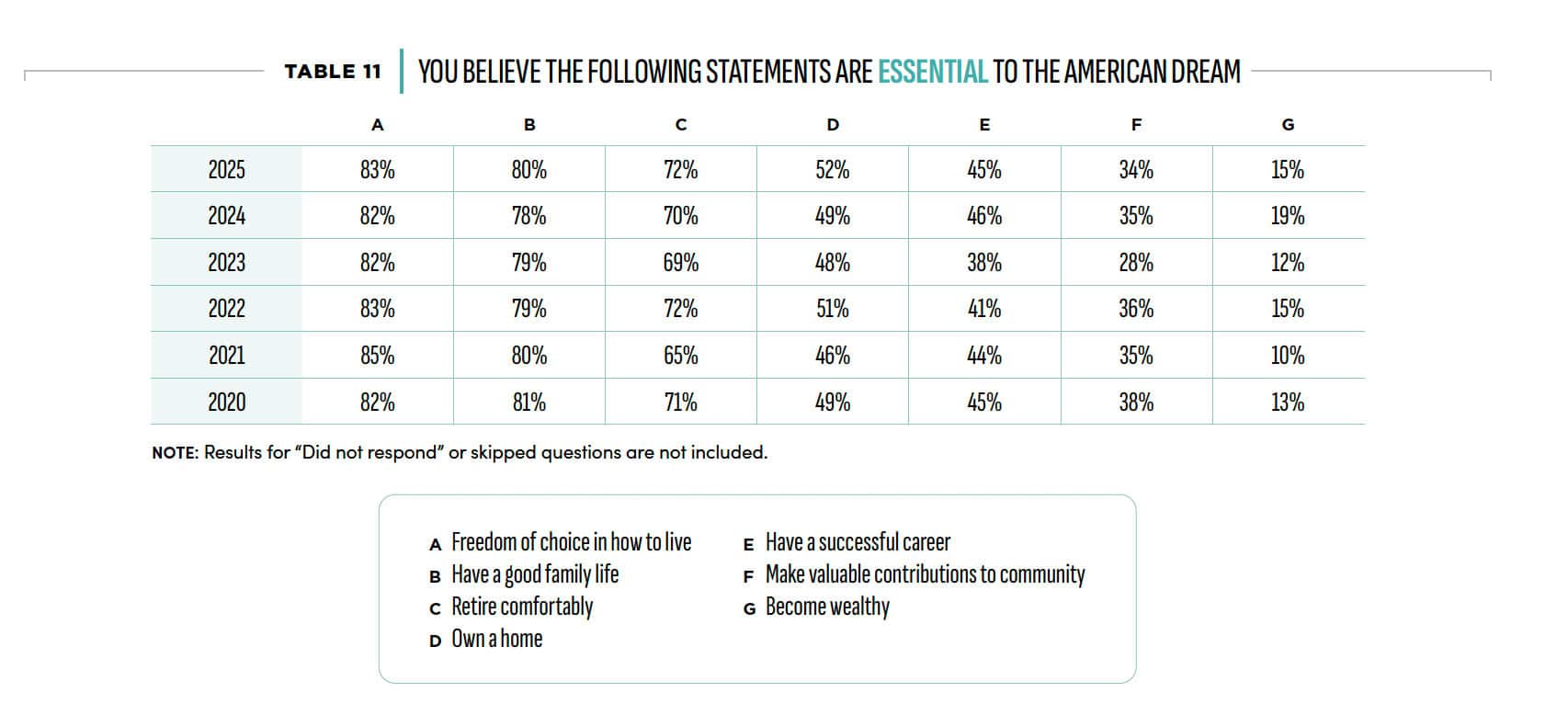
Delving deeper into the demographic results, we see consistent findings across Table 12. “Freedom of choice in how to live” and “having a good family life” are the most essential achievements for all age, education, ethnic, income, and political groups. Just 15% of Americans overall view “becoming wealthy” as essential to the American Dream. However, this view is slightly more popular among younger Americans, people without a college degree, Black Americans, and Independents.
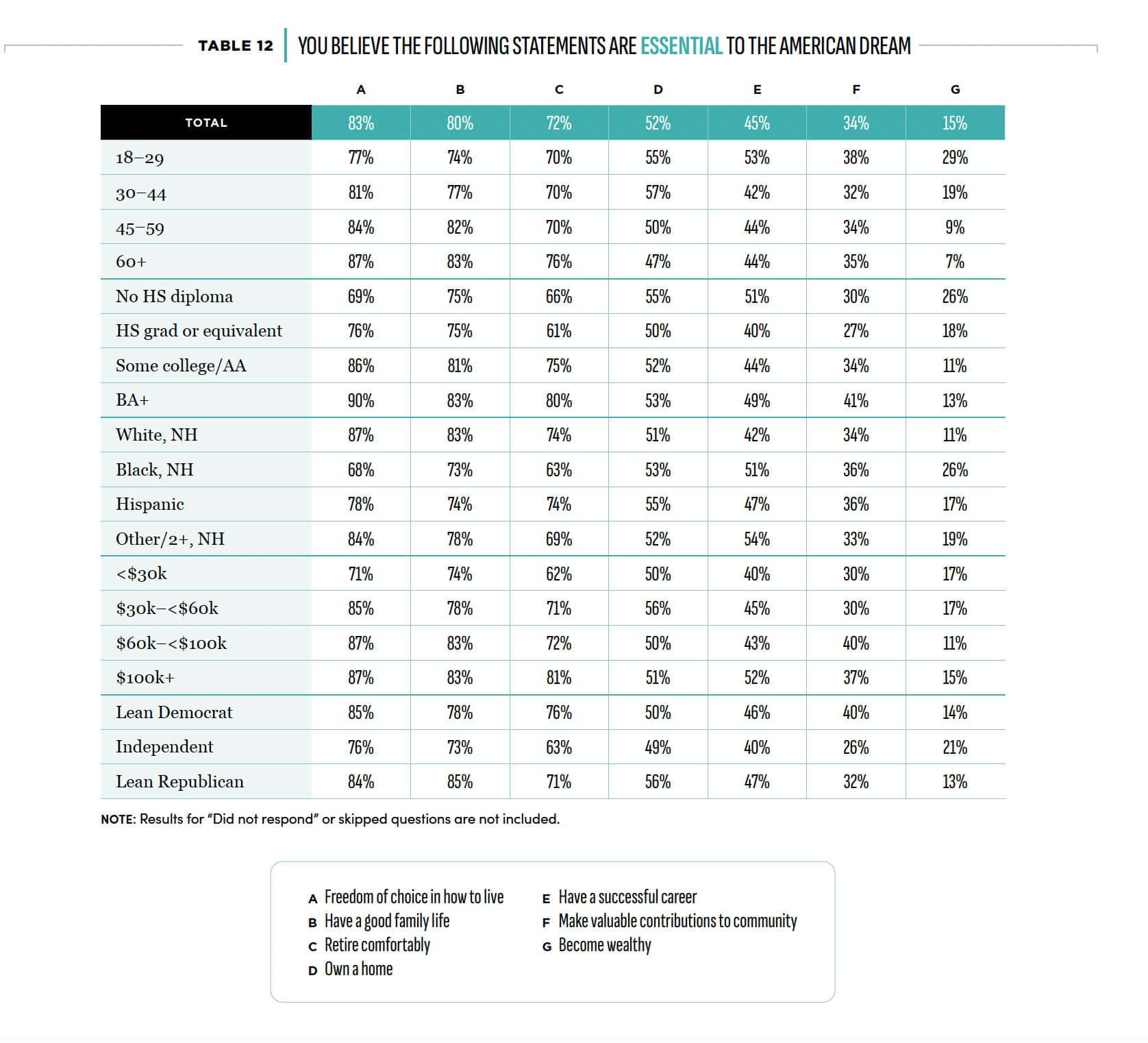
Do We Have More Opportunities?
An abundance of opportunity continues to be closely associated with the American Dream and the American Experiment. The United States is described as “the land of opportunity,” often due to its dynamic economy, diverse population, and vibrant labor market, which attract immigrants from around the world.
This view is closely associated with social mobility—or the idea that children will have a better life than their parents. We dive into these questions in Tables 13-18, first focusing on people’s experiences compared to their parents and then on their expectations for their children.

According to our survey, most Americans believe they have more or the same opportunities for success as their parents. About one-quarter of Americans think they have fewer opportunities than their parents, which is similar to last year’s results and up from previous surveys.
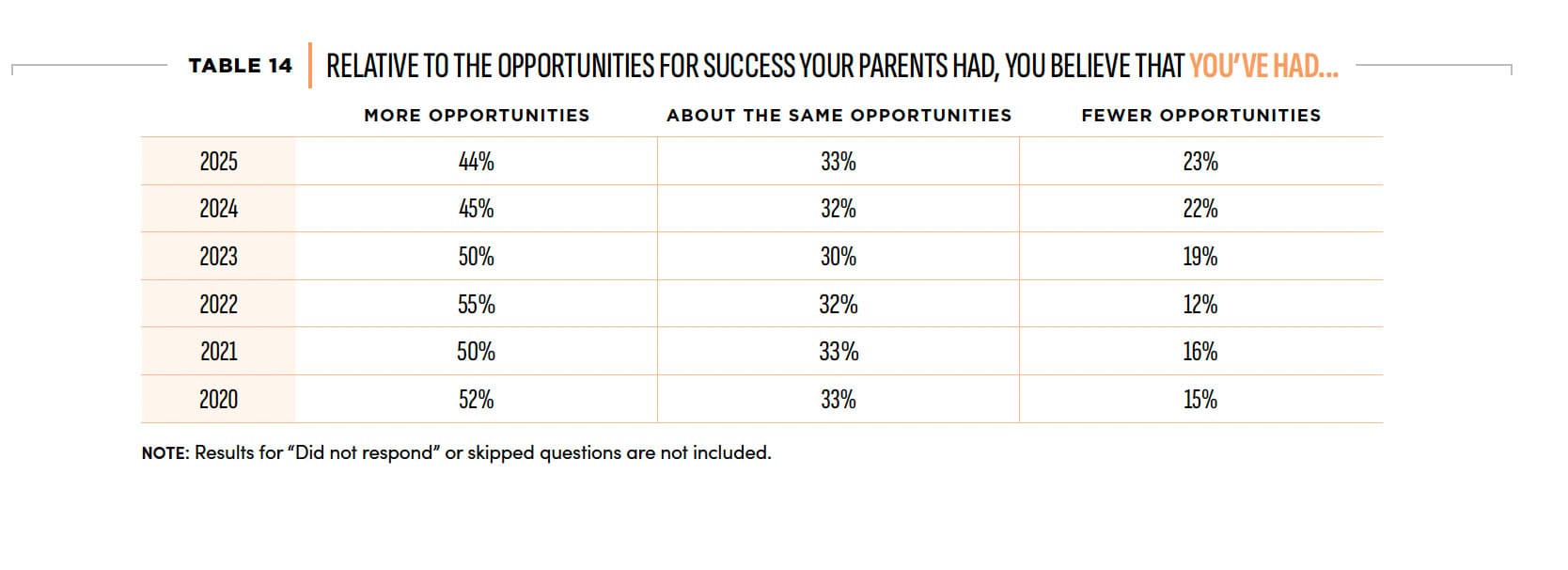
Table 15 shows how different demographic groups responded to this question. You can see a continuing trend where younger cohorts hold more negative views than older generations. In this case, about 3 in 10 adults under the age of 45 believe they have fewer opportunities than their parents. Among adults ages 60+, only 11% hold this view.
Other groups who are less likely to say they face fewer opportunities than their parents include Black Americans, people with a college degree, high-income earners, and Republicans. Independents are the most pessimistic political group on this question.
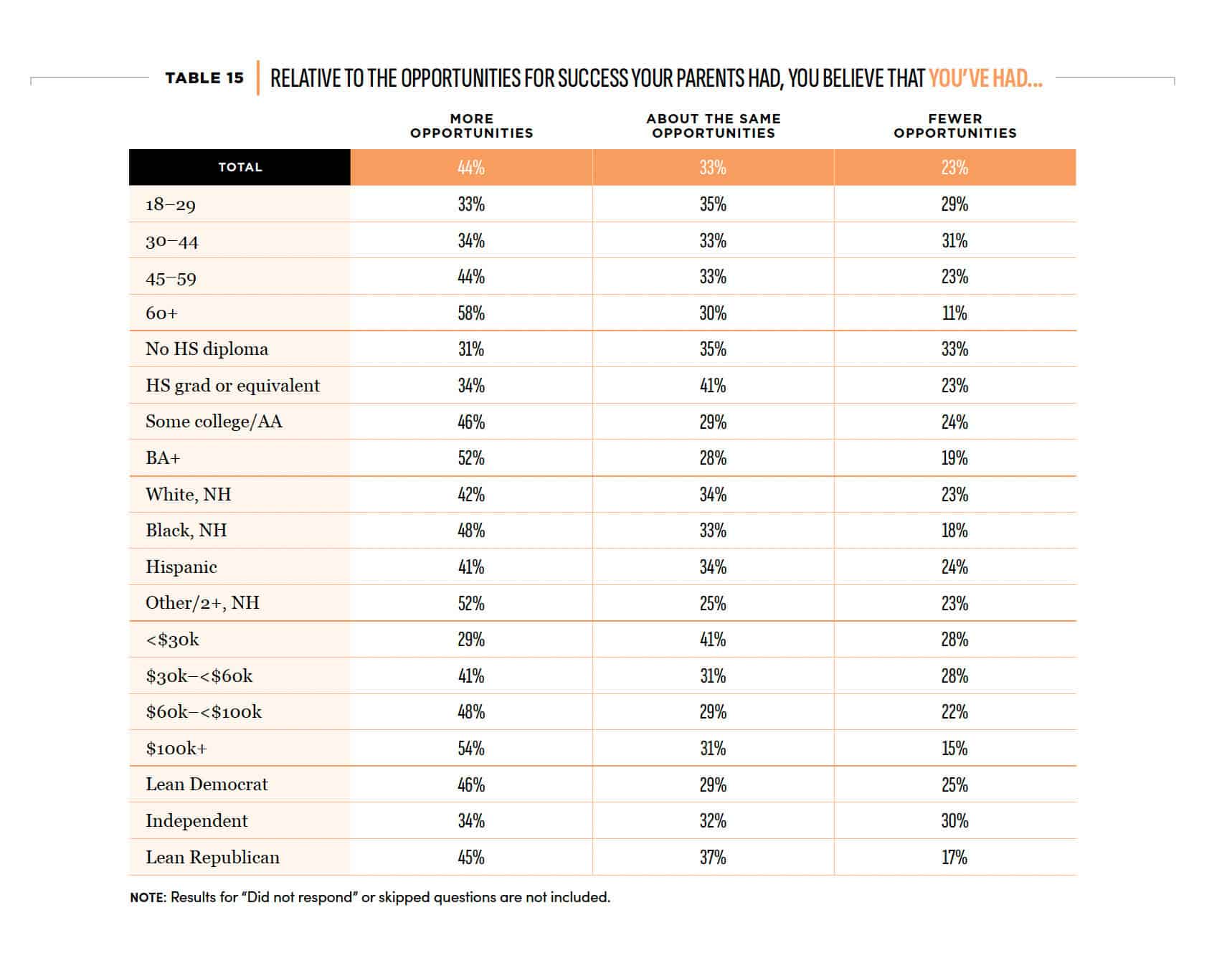
Turning to the next generation, people are overall positive about their children’s opportunities for success. When we adjust for the 20% of respondents who don’t have children, we find that 37% of parents believe their children will have more opportunities than they had in life; 33% say they will have the same opportunities; and 30% believe their kids will have fewer opportunities.
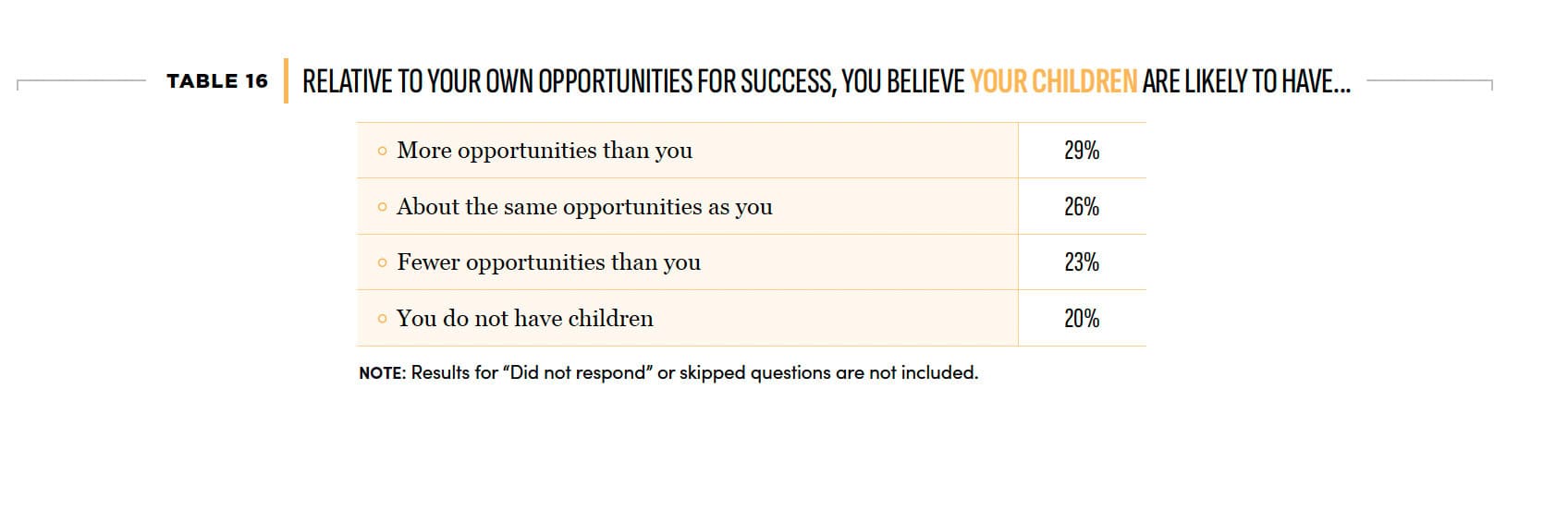
A similar percentage of people are pessimistic about their kids’ future as those saying the American Dream is out of reach. When we compare results across time, we see a trend of growing pessimism among parents. This is an important indicator to watch in future editions, as it could symbolize a reduction in hope for the future.
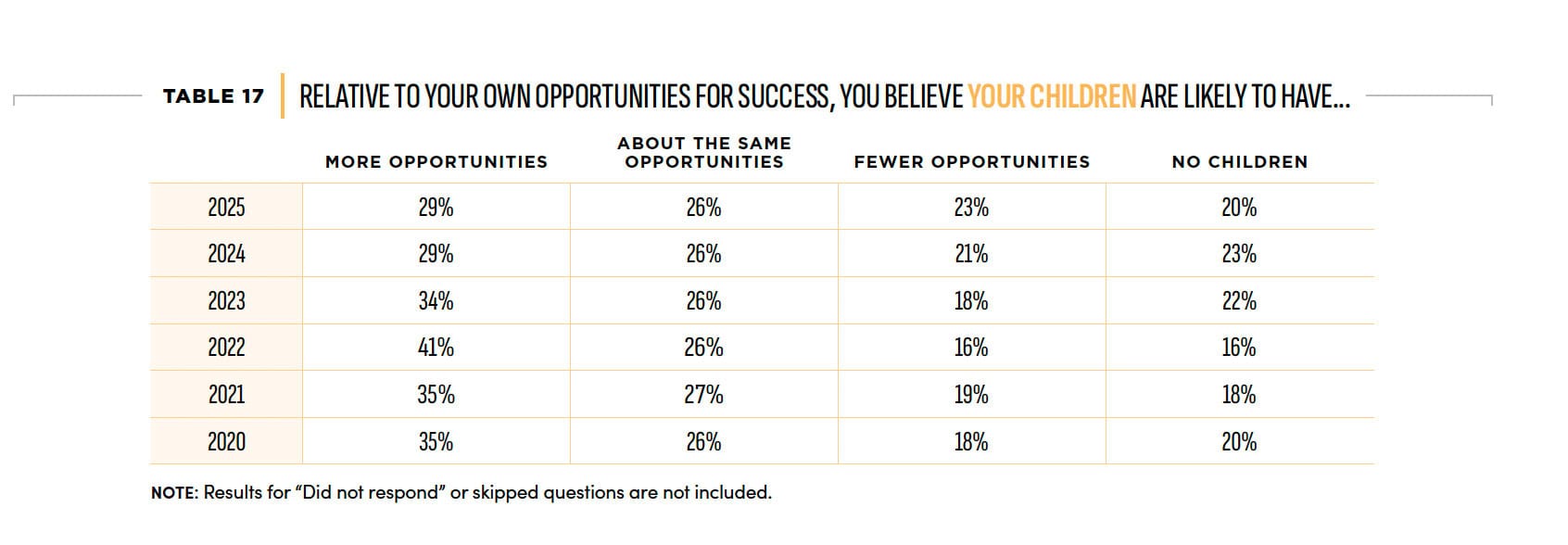
Table 18 shows the demographic breakdown for these results. Interestingly, we see many of the previous trends reversed for this question. People with less education and lower incomes are associated with greater optimism for intergenerational opportunity, likely driven by the lower starting point of the parents. The most optimistic group of parents are Black Americans, with 42% believing their children will have more opportunities than they had. There are some differences among political groups, with 35% of Republicans believing their children will have more opportunities compared to 30% of Independents and 24% of Democrats.
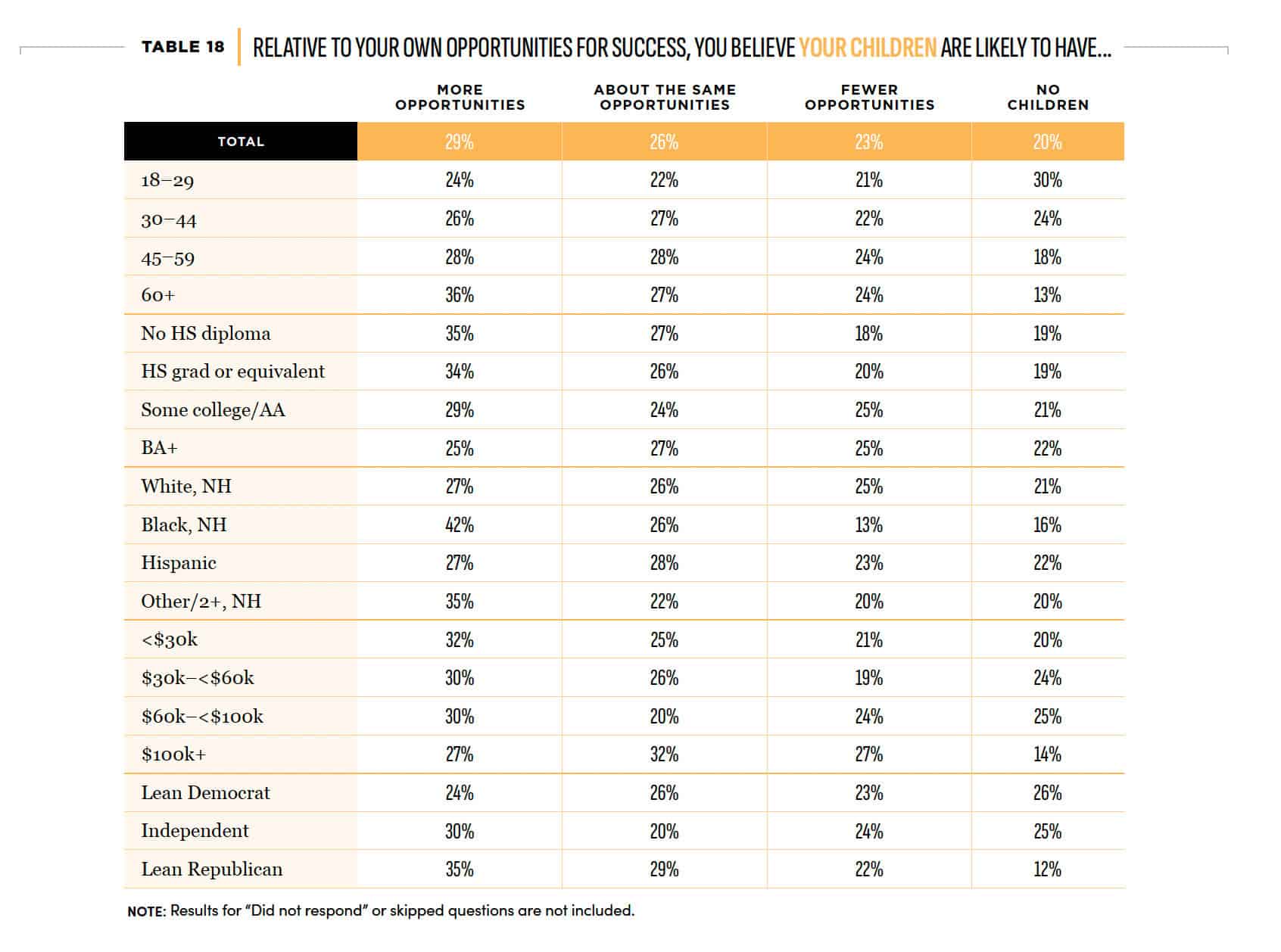
The American Dream and Trade
One of the most important economic issues this year is trade. On April 2, 2025, dubbed “Liberation Day” by the Trump administration, the United States announced a reciprocal tariff strategy with new, higher tariffs for nearly all countries. This strategy was framed by the Trump administration as a “win” for American manufacturers and workers, claiming the policy would boost American jobs and generate revenue to reduce taxes and pay down the national debt. The announcement triggered economic uncertainty as global markets crashed and foreign and domestic businesses sought to adjust to higher costs on imports. Economists derided the policy as “a disaster” and warned that it would likely lead to more expensive goods, inflation, supply chain disruptions, and loss of jobs and business investment.
Clearly, Americans are being presented with two opposite stories: one where higher tariffs lead to more opportunity at home, and another where tariffs unleash poor economic conditions that raise barriers. To understand how this issue is being perceived, we asked Americans whether they believe the federal government’s recent increase on tariffs will help, harm, or have no effect on their pursuit of the American Dream. Table 19 shows the results.
A majority of Americans, nearly 6 in 10, believe President Trump’s trade policy will stand in their way of achieving the American Dream. Just 12% say it will help them achieve the American Dream, while 28% believe it will have no effect.

In Table 20, we see a predictable divide along party lines. However, only 24% of Republicans believe increased tariffs will improve their chances of achieving the American Dream. That number is 9% among Independents and 2% among Democrats. On the other hand, 82% of Democrats believe the policy will harm their chances of achieving the American Dream, compared to 55% of Independents and 31% of Republicans.
Notably, the policy remains unpopular even among those with less education and income, the groups purported to benefit according to the administration. Tariffs are one of the few areas where economists overwhelmingly agree on their pernicious effects on the economy, and it seems the people agree as well. There is widespread skepticism among Americans that Trump’s trade policy will positively affect their pursuit of the American Dream.
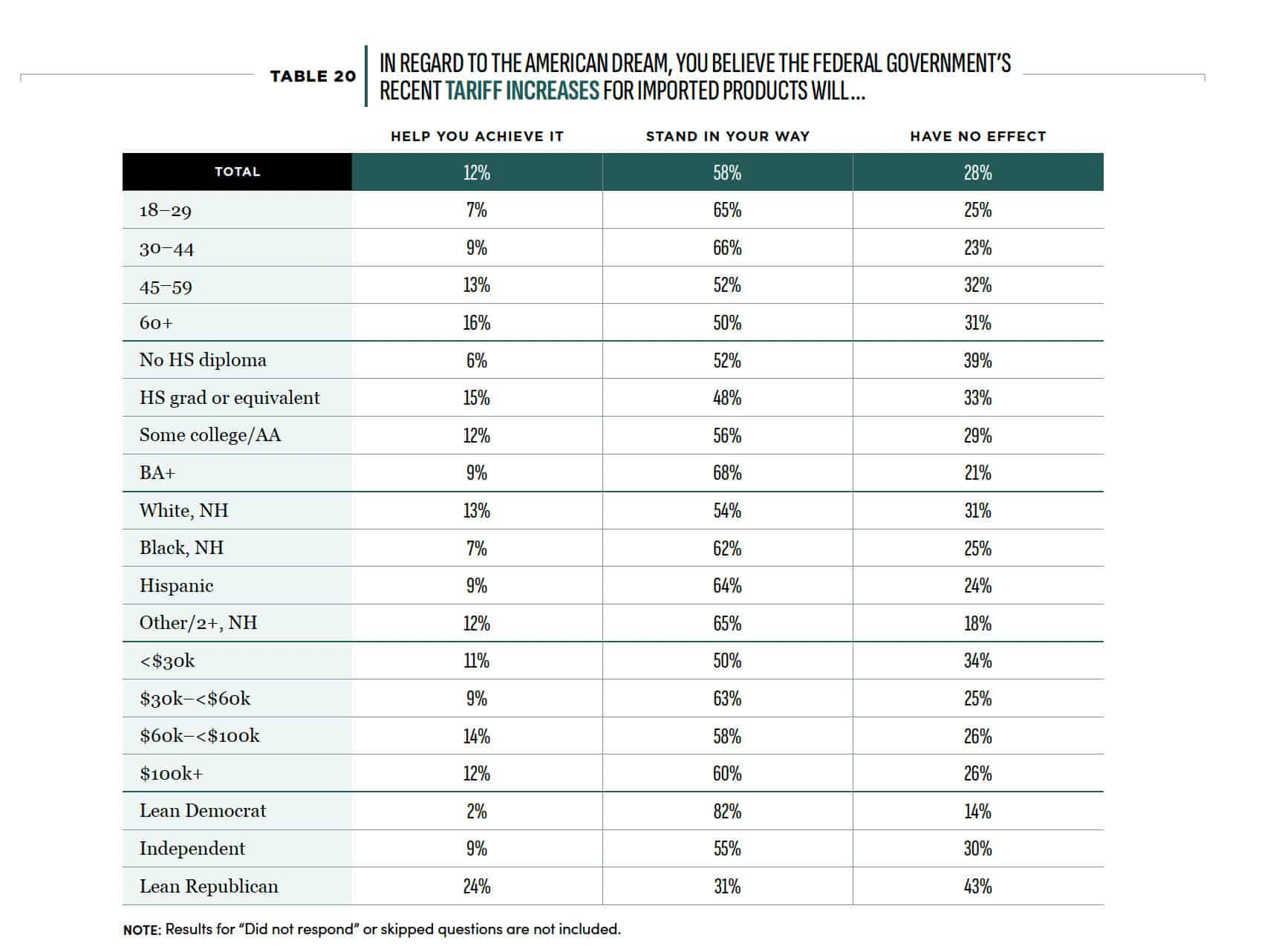
The American Dream and Technology
Another dynamic topic this year is the advancement of artificial intelligence. People have argued that this technology could be a catalyst for unprecedented prosperity or the end of civilization. Discussions abound in public and policy forums about what effect artificial intelligence is likely to have on our economic and personal lives. Just as Americans have taken a holistic view of the American Dream, attitudes about artificial intelligence are similarly nuanced and multifaceted, with people concerned about its impact on jobs, meaning, democracy, mental and social health, and more. For this survey, we asked people whether they believe recent technological advancements such as artificial intelligence will help, harm, or have no effect on their pursuit of the American Dream. The results can be found in Table 21.
As you can see, the most common view among Americans is that artificial intelligence will have no effect on their pursuit of the American Dream. Just over half of respondents hold this view, while 31% see it as a threat, and 16% see it as a potential aid. It is not clear whether this view stems from doubt in the power and capabilities of technology, or whether people believe they will be able to effectively cope with the changes it brings.

Younger Americans are slightly more pessimistic about the rise of artificial intelligence than older cohorts. This result is likely driven by the larger anticipated impact of new technology on younger generations. Unlike the previous question, attitudes are consistent across political groups and many other categories.
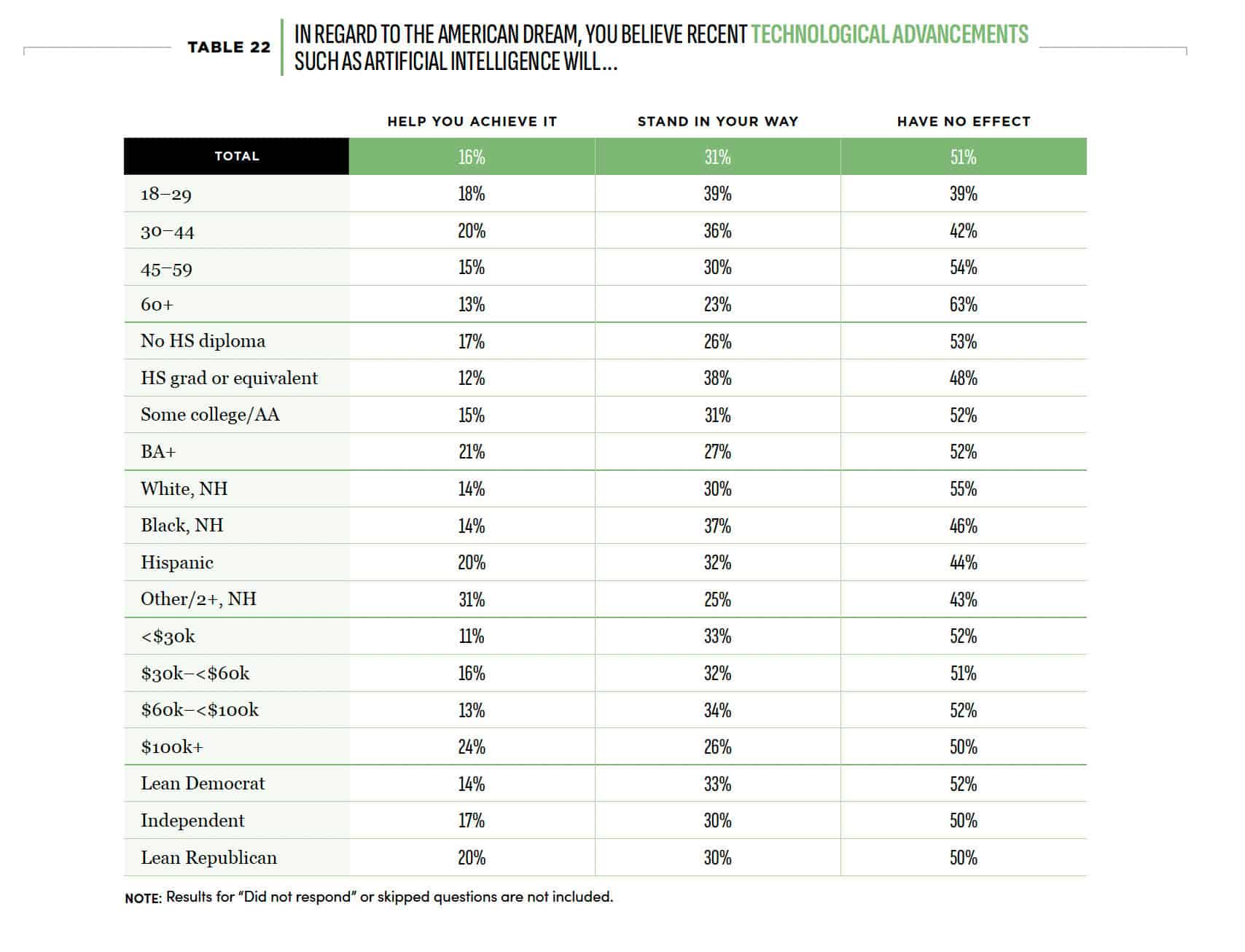
Because technological progress is happening rapidly, this will be an important topic to continue monitoring. The Archbridge Institute’s Human Flourishing Lab maintains another survey project, called Progress Pulse, which focuses on tracking people’s attitudes toward progress, including the impact of technology.
Conclusions
Despite challenging economic and political conditions, Americans continue to believe in the American Dream. This year’s report showed a slight improvement in the health and state of the American Dream. However, optimism continues to lag below the levels seen before 2024. We must ensure that criticism and pessimism about the American Dream does not become a self-fulfilling prophecy, even as we continue striving to remove barriers to opportunity.
Lessons from this snapshot can keep us hopeful. Most Americans still believe in the promise of America. Most Americans believe the American Dream can unite us around a shared belief, regardless of our different backgrounds and viewpoints. Most Americans believe they have more or the same opportunities as their parents, not fewer. Most Americans agree that freedom is essential to the pursuit of the American Dream. Lastly, even among those who are negative about the American Dream, most believe it is economic barriers—and not personal or cultural obstacles—that stand in their way. That gives us hope that we can find better policies and positive-sum solutions that ensure all Americans have an opportunity to pursue the good life and achieve their full potential.
The national ethos of the American Dream is the fuel that keeps the promise of America alive. Data, national narratives, and inspiring stories of people chasing and achieving the American Dream can influence and refuel the Dream for future generations. The future of the American Dream depends on us—individual and aspiring Americans—who dare to dream and believe in its promise. It is up to us to lead by example and keep the flame of the American Dream alive while promoting an uplifting culture of human flourishing for all.
Previous Snapshots
Gonzalo Schwarz is the President and CEO of the Archbridge Institute. Follow his work @gonzaloschwarz and subscribe to his newsletter, Living the Dream.

